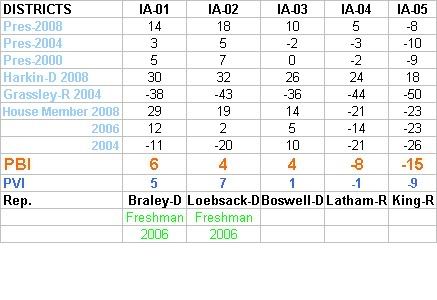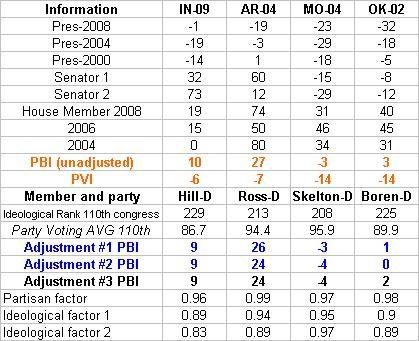I was asked by desmoinesdem at swing-state-project.com to crosspost here. I normally post there and at dailykos.com. PBI or Party Brand Index is a concept I have developed as a replacement for PVI. PVI (Partisan Voting Index), which is measured by averaging the percentage of the vote from the last two presidential elections in each house district, and comparing it to the nation as a whole, is a useful shorthand for understanding the liberal v. conservative dynamics of a district. But PVI in my opinion it falls short in a number of areas. First it doesn't explain states like Arkansas or West Virginia. These states have districts who's PVIs indicates a Democrat shouldn't win, yet Democrats (outside of the presidency) win quite handily. Secondly why is this the case in Arkansas but not Oklahoma with similar PVI rated districts?
Lastly PVI can miss trends as it takes 4 years to readjust. The purpose of Party Brand Index is to give a better idea of how a candidate does not relative to how the presidential candidate did, but compared to how their generic PARTY should be expected to perform. I've tackled IN, NC, CO, VA, MO, OK, AR, now I will look at the swing states of Nevada and Iowa.
First I would like to post the data, then I will offer some analysis. My basic pattern is to work my way “out” from the “Purple States” to the more Blue and Red ones. Two weeks ago (I took one week off for Netroots Nation) I skipped my normal pattern of working out from purple states. I became curious on how my model would work in states like Arkansas that are deeply blue at the local level, but deeply red at the presidential level. I will offer a refresher on them later. But first let's examine the swings states of Iowa and Nevada.
IOWA

NEVADA

Both of these states have fairly “straightforward” Democratic or Republican leaning districts, only Iowa Rep. Boswell is a Blue Dog. Rep. Titus in Nevada's 3rd district was designed as a swing district where there would be a equal number of Democrats and Republicans. PBI maintains this is still the case, while PVI suggest a slight Democratic lean. Also Republican Rep. Lantham of Iowa who is frequently mention as a target of Democrats because of his district's PVI of only +1 Republican, is actually much safer based on PBI -8 (the equivalent of a PVI of 8), which is much closer to his winning margins.
Just a quick note as a reminder on Blue Dogs like Boswell, I developed a “correction factor” that allows for a better “explanation” for congresspersons who win districts that are a “mismatch” for their party's majority ideology. I would prefer to run a “batch” of these at a time. So I will simply republish the results for the four Blue Dogs I have encountered since I started this research.
FOUR BLUE DOGS

I developed a formula based on standard deviations. Basically I can figure out how much the average rep deviates from their district. If I then compare where a reps voting pattern falls (in what percentile) and compare it to their district's PVI, I can develop a “standard deviation factor”. Inside the standard deviation will get a bonus, outside a negative. The idea is that if a Blue Dog has a very conservative record, they may be surviving not because of a districts Democratic leanings but because they deviate from Democratic policies. I showed all three variation of my formula but for future examples I will stick to ADJUSTMENT FACTOR #2.
For example, if Rep X is the 42 most conservative rep, that would place her in the 90th percentile. But if her district's PVI was “only” the in the 60th, their is a good chance her margins would be effected. Using a few random samples I found most reps lie within 12% of their district's PVI.
Using these dummy numbers I then came up with this.
SQRT[(30-12)^2 /2] = about 13%
Her factor would then be 100 – 13 = 0.87.
So her victory margin would be weighted by 0.87 because she is more than 12% beyond her acceptable percentile range it making the victories in her district approximate 13% less “representative”.
My theory yields the following formula:
If rep's voting record is > PVI then
100 – SQRT[({Record percentile – PVI} – Standard PVI Sigma)^2 /2] = factor
else if rep's voting record < PVI
100 + SQRT[({Record percentile – PVI} – Standard PVI Sigma)^2 /2] = factor
I then repeated this formula to calculate a partisanship correction factor. Ranking a members ideology is a subjective decision. Potentially what's one person “liberal” position, is another person “conservative” ones, remember the wingers developed a model that ranked the Sen. Obama as more liberal than Bernie Sanders or Russ Feingold. But partisanship, how often a member votes with their party is an absolute number. A Democrat who represents a “republican district” would be expected to “break with their party” on votes that don't reflect their districts values.
I couldn't find a website that ranks all the districts based on their PVI (I only could find list of them by state not rank, help please anyone), therefor I substituted a PVI ranking with where each member ranked in the Democratic caucus. In the 110th Congress the average Democrat had an ideological ranking of 170 (by the way this is a result of several members being tied, this is the medium not the midpoint). The average of members towards the center was 191, former Daily Kos celeb Ciro Rodriguez fell at exactly 191. The average of members towards the liberal side was 121, which falls between Rep. Larson of Conn. and Rep. Eshoo of CA. As or partisanship in the 110th Congress the average Democrat voted with their party 92.3% of the time.
As a clarification in Adjustment #1, I used a deviation factor based on how far each member was from the center of the Democratic caucus. Adjustment #2 was based on how far each member was from outside the standard deviation of the caucus. In Adjustment #3 I removed the partisanship factor to see what effect it would have.
Because there are “only” 50 states (as opposed to evaluating 435 house members), I will at a later date have all the states ranked by PVI so I can adjust the Senator's rankings. I developed Senate factors for the four states the four blue dogs came from. In the interest of full disclosure, my source for ideological rankings is Voteview, and for partisanship it was the Washington Post. This is still a work in progress, I'm making adjustments, and continuing to crunch numbers for more states. I also will use the adjustment factor on a liberal member of congress to see what effect that will have.
……………………………………………………………………………………….
An explanation for 1st time readers on how PBI is calculated.
To compute PBI I basically did the following. I weighed the last 3 presidential elections by a factor of 0.45. Presidential preference is the most indicative vote since it's the one politician people follow the most. The POTUS is the elected official people identify with or despise the most, thus illuminating their own ideological identification. I then weighed each house seat by 0.35. House seats are gerrymandered and the local leader can most closely match their districts make up in a way the POTUS can't. So even though they have a lower profile I still gave them a heavy weight. Lastly I gave the last two Senate elections a weight of 0.2. Senatorial preference can make a difference, although I think it's less than that of the President or the House members. Also (more practically) because I have to back calculate (estimate) Senate result totals from county results, a smaller number helps lessen the “noise” caused by any errors I may make. Under my system Democratic leaning have a positive number, the GOP has a negative number.
I then decided to go all Nate Silverish and gave more recent elections a greater weight. I gave an addition 5% weight to each election as it got closer to the most recent election. To be honest I pulled 5% out of my dairy air but Nate gave a similar weighting to poll results as fresher ones came in 2008, so I copied this formula.
The next issue I decided to tackle was to develop a way to weight for incumbents. The reelection numbers for incumbants is so high it would be a mistake to weight a district soley on the fact that an incumbat continues to get elected. There is a long list of districts that have PVI that devate from their incumbant members, whom none the less keep getting elected. These disticts then change parties as soon as the incumbant member retires. This is evidence that incumbancy can disguise the ideology of voters in a district.
I decided on a weight of about 7% for House members. I remember reading that incumbency is worth about 5-10%. Also Nate wrote in a 538.com article that a VP pick from a small state was worth about a 7% swing, a house seat could in fact be thought of as a small state, that seems as good a number as any to start from. Conversely I will deduct 7% from an incumbents win. I think this will score them closer to the natural weight of a district. By the way I'm weighting the win 7% less, not actually subtracting 7% from the number. Open seat races will be considered “pure” events and will remain neutral as far as weighting goes. A seat switching parties will also be considered a neutral event. The 1st defense of a seat by a freshman house member will be given a weighting of 2%. The toughest race for any incumbant is their 1st defense. I decided to adjust for this fact. Note: Indiana's bloddy 9th was a tough call a case could be made that when a seat keeps flipping, and the same two guys run 4 straight times in a row each election should be a neutral event.
Senate weighting will be as follows. In state with a single House seat the Senate seat will be weighted the same as a house. In states with mutiple seat, the Senate will get a wighting of 2%. Nate Silva stated that a VP pick in a large state is worth this amount. An argument could be made for a sliding scale of Senate weighting from 2-7%, this added complexity may be added at a later date. I will give incumbant presidents a 2% weighting, until I get better data on how powerful a “pull” being the sitting POTUS is, I will give them the same weighting as a senator.
The main purpose of Party Brand Index is to give a better idea of how a candidate does not relative to how the presidential candidate did, but rather compared to how their generic PARTY would be expected to perform. I'm calling this Party Brand Index.

1 Comment
I sympathize
with your goal, but I’m having a hard time following the calculations of PBI, especially the weighting. Could you run some sample calculations using an actual district?
iowavoter Sun 30 Aug 11:58 AM